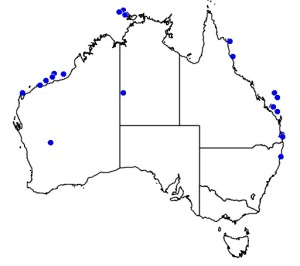
©Anne Hoggett: Comaster nobilis in typical living position at the base of the reef slope at Pidgin Point, Lizard Island.

©Lyle Vail and Anne Hoggett: Underside of Comaster nobilis. Note virtual absence of cirri and relatively smooth, solid central area.
Colours
Distinguishing features
Comatulids are distinguised from all other featherstar families by having terminal segments of the oral pinnules modified to form a comb. Comatulids a also have a distinctive "feel" due to well developed hooks on most pinnules that cause them to cling like velcro.
Comaster nobilis lives fully exposed with its numerous arms held in a bush-like posture. There are usually no cirri but some individuals have a few weak ones. The central area of the underside is very solid and smooth.
The most common colour is white on the under surface near the centre, becoming yellow/brown in the distal half. Pinnules are usually speckled with a combination of white and yellow, sometimes with some black and green.
The distinctive colour pattern and smooth undersurface help distinguish this species from Comaster audax, which is often found in the same habitat and has a similar living position.
It can be distinguished from Comaster schlegelii by its absence of cirri, colour pattern (C. schlegelii does not have large areas of white), habitat (C. schlegelii lives close to the reef crest among corals) and living position (C. schlegelli is tightly sequestered within the reef).
Summers et al (2017) relegated C. nobilis to the synonymy of C. schlegelii based on low divergence of COI between individuals identified as those nominal species. We have retained both names here because the two forms are identifiable both in the field and by morphological differences as outlined by Rowe et al (1986).
Size
- Size data has not been obtained.
Depth range
- Depth range data is not yet available.
Synonyms
Distribution
Distribution and habitat preferences
It perches on both soft and hard substrates, including hard and soft corals, algae and rubble.
Comaster nobilis is found mostly in water deeper than 10 m, anywhere around the perimeter of the island group. Messing (2006) records Comaster nobilis as part of an unusual soft-bottom fauna in 12 to 17 m depth off Osprey Island.
Web resources
References
References that assist with identification
- Clark, A.M. and F.W.E. Rowe (1971). Monograph of shallow-water Indo-west Pacific echinoderms British Museum (Natural History), London.
- Rowe, F.W.E., A.K. Hoggett, R.A. Birtles and L.L. Vail (1986). Revision of some comasterid general from Australia (Echinodermata: Crinoidea), with descriptions of two new genera and nine new species, Zoological Journal of the Linnean Society, 86: 197-277. LIRS catalog number 198.
- Summers, M.M., C.G. Messing and G.W. Rouse (2017). The genera and species of Comatulidae (Comatulida: Crinoidea): taxonomic revisions and a molecular and morphological guide. Zootaxa, 4268(2): 151-190. LIRS catalog number 2197.
- View all references



